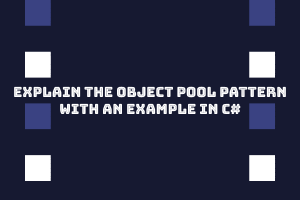The Object Pool pattern is a creational design pattern used to efficiently manage a pool of reusable objects. It is particularly beneficial when object creation and destruction are resource-intensive and can impact performance. Instead of creating new objects whenever needed, the pattern maintains a pool of pre-initialized objects that can be reused.
In the provided example, we have a Connection class representing a connection to a resource. The ObjectPool class manages a pool of Connection objects. The pool is initialized with a fixed number of connections, and each connection is identified by a unique Id. When a connection is needed, the pool checks if there are any available connections. If an available connection is found, it is taken from the pool. Otherwise, a new connection is created.
The GetConnection method in the ObjectPool class handles the process of obtaining a connection. When a connection is no longer needed, it can be returned to the pool using the ReturnConnection method, making it available for future reuse.
By using the Object Pool pattern, we can reduce the overhead of creating and destroying connections, leading to better performance and resource utilization.
Paraphrased Example (Object Pool in C#):
using System;
using System.Collections.Generic;
// A hypothetical Connection class representing a connection to a resource.
public class Connection
{
public int Id { get; private set; }
public Connection(int id)
{
Id = id;
Console.WriteLine($"Connection {id} created.");
}
public void Connect()
{
Console.WriteLine($"Connection {Id} opened.");
}
public void Close()
{
Console.WriteLine($"Connection {Id} closed.");
}
}
// ObjectPool class managing the pool of Connection objects.
public class ObjectPool
{
private Queue<Connection> availableConnections;
private int nextConnectionId = 1;
public ObjectPool(int poolSize)
{
availableConnections = new Queue<Connection>();
for (int i = 0; i < poolSize; i++)
{
var connection = new Connection(nextConnectionId++);
availableConnections.Enqueue(connection);
}
}
public Connection GetConnection()
{
if (availableConnections.Count > 0)
{
var connection = availableConnections.Dequeue();
Console.WriteLine($"Connection {connection.Id} taken from the pool.");
return connection;
}
var newConnection = new Connection(nextConnectionId++);
Console.WriteLine($"A new connection {newConnection.Id} created.");
return newConnection;
}
public void ReturnConnection(Connection connection)
{
availableConnections.Enqueue(connection);
Console.WriteLine($"Connection {connection.Id} returned to the pool.");
}
}
public class Program
{
public static void Main()
{
const int poolSize = 3;
var pool = new ObjectPool(poolSize);
var connection1 = pool.GetConnection();
connection1.Connect();
connection1.Close();
pool.ReturnConnection(connection1);
var connection2 = pool.GetConnection();
connection2.Connect();
connection2.Close();
pool.ReturnConnection(connection2);
var connection3 = pool.GetConnection();
connection3.Connect();
connection3.Close();
pool.ReturnConnection(connection3);
}
}
Explanation:
In this example, we illustrate the Object Pool pattern using a hypothetical Connection class. The Connection class represents a connection to a resource, and it has methods for connecting and closing the connection. The ObjectPool class manages a pool of Connection objects using a queue to keep track of available connections. The pool is initialized with a fixed size, and each connection is identified by a unique Id.
In the ObjectPool class, the GetConnection method is responsible for obtaining a connection from the pool. If an available connection exists, it is dequeued from the pool and returned to the caller. Otherwise, a new connection is created and returned.
In the Main method, we demonstrate how to use the Object Pool by requesting connections from the pool, using them, and then returning them to the pool for reuse. The console output shows the lifecycle of each connection, including creation, usage, and return to the pool.
Overall, the Object Pool pattern is useful in scenarios where object creation and destruction are expensive operations, and reusing existing objects can lead to performance improvements and better resource management.
People having good knowledge of Financial accounting can get an Accounting Certification Exams from StudySection to increase their chances of getting a job in this field. You can get a foundation level certification if you are new to Financial accounting or you can go for advanced level certification if you have expert level skills in Financial accounting.




